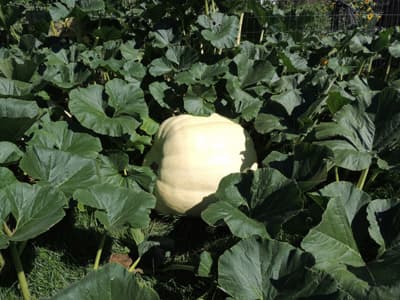Watering pumpkins is a regular routine for most pumpkin growers during the hottest and driest months of the summer. However, there are right ways and wrong ways to accomplish this task. While water, and plenty of it, is vital to growing big pumpkins, what is really important, is a steady level of moisture in the soil for the roots to tap into. The goal of this article on “How to Water Pumpkin Plants”, is to ensure the healthy and maximum growth of your plants and fruit.
The ideal conditions is moist soil, not too wet as to rob oxygen from the soil and dilute fertilizers and nutrients. Your soil should not be allowed to dry out either. The notion that allowing the soil to dry will cause the plant to broaden and deepen it’s roots is true, but only to an extent. In addition, for growers seeking the maximum size, you can’t risk providing less than optimum conditions even for a few days, as the real lunkers grow as much as 40-50 pounds a day.

Water is a vital necessity for growing the “Big One”. I’ve read where pumpkins have shallow roots. A friend of mine who farmed in Italy told me that pumpkin roots run deep, seeking water. He continued that they are best grown where the water table is near the surface, or near a creek where the soil contains more moisture.
Most of us, especially in suburbia, have little choice of location. And, when we do have some choice, we choose the sunniest site first, as we can always provide water through some means of irrigation. Therefore, it doesn’t matter whether the roots are shallow or deep. As mid summer approaches, almost all avid growers need to bring water to the vine on a regular and consistent basis.
Listed below are some of the methods used when watering pumpkins.
These are the top choice for primary watering. Coupled with a small tank, water can be continuously provided to the roots, and will not water the weeds at the same time. In addition, you can add fertilizer to the water in the tanks and direct feed the roots.
The use of soaker hoses underground requires a little early season planning. Some farmers bury hoses in concentric circles or ovals. As the plant grows, they turn on the second then third rings of hose. The result is underground watering to the entire area where the plant will spread. The benefits go to the main vine, as well as the many side shoots which will form secondary roots and draw upon the moisture you have put into the soil. You may have to train your vine towards the intended area.
A second method is to bury a soaker hose under the area where the main vine will be. This will amply supply water to the many secondary roots along the main vine. However, it will not provide extra water to secondary roots. For suburban gardeners this may prove the best approach ,as suburban growers have little choice but to let the vines grow across the lawn and are adverse to digging into major areas of the lawn. Water to the side shoots can be provided by other means.
Placement of the hose should be just below the surface. The water will soak down to the deep roots and you do not want to miss the many shallow roots near the surface.
A third method is to place a soaker hose on the top of the soil, pointing the holes downward. Then, cover the hose and the vine with soil or mulch(well decomposed). This is simple and quick.
I consider the sprinkling can to be the second most important watering tool. Where soaker hoses are the paint roller, the sprinkling can is the finishing brush. Coupled with an underground soaker hose, they do a thorough job, without watering all of the weeds as well.
Of all the ideas on how to water pumpkin plants, the use of overhead sprinklers poses the potential for serious problems with your plant. Although overhead sprinklers are quick, easy and if left on long enough, they are thorough. But, too many gardeners are unaware of the fact that moisture and humidity lead to plant diseases. If you water after work towards evening during hot and muggy summer nights, you are inviting disaster. If you must use and above ground sprinkler, do so during the mornings or even afternoon if at all possible.
Importantly, use a sprinkler that delivers a soft spray. Pumpkin leaves can be broken and damaged by a strong steam of water.
This is also is a common suburban watering method. It applies the water, but otherwise has no advantage. In addition to the risks with above ground sprinklers, it take more time to stand there and water the plants. Many users may be impatient and not water long enough. In addition, the stronger, more direct flow can result in broken or damaged leaves.
Irrigation ditches are also effective in providing water to the plants. They have the advantage of minimizing water on the leaves and can be applied day and night. Their biggest disadvantages is that lots of the water goes to places other than the desired plants’ roots and a lot of water is consumed. In addition, you need to dig the ditch. This is generally used for commercial applications and not practical for small home garden use.


